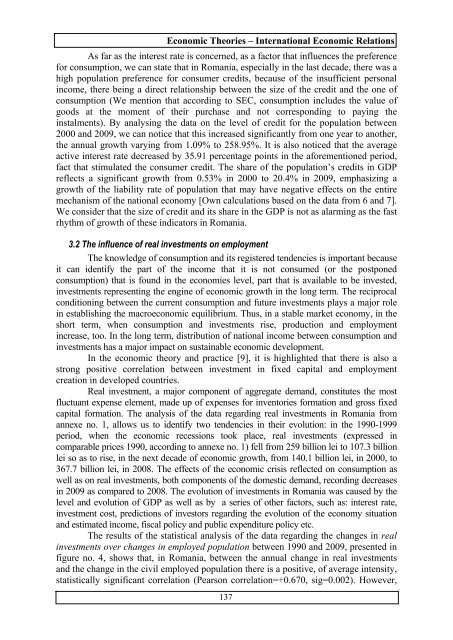Revista Tinerilor Economiºti (The Young Economists Journal)
Revista Tinerilor Economiºti (The Young Economists Journal)
Revista Tinerilor Economiºti (The Young Economists Journal)
You also want an ePaper? Increase the reach of your titles
YUMPU automatically turns print PDFs into web optimized ePapers that Google loves.
Economic <strong>The</strong>ories – International Economic Relations<br />
As far as the interest rate is concerned, as a factor that influences the preference<br />
for consumption, we can state that in Romania, especially in the last decade, there was a<br />
high population preference for consumer credits, because of the insufficient personal<br />
income, there being a direct relationship between the size of the credit and the one of<br />
consumption (We mention that according to SEC, consumption includes the value of<br />
goods at the moment of their purchase and not corresponding to paying the<br />
instalments). By analysing the data on the level of credit for the population between<br />
2000 and 2009, we can notice that this increased significantly from one year to another,<br />
the annual growth varying from 1.09% to 258.95%. It is also noticed that the average<br />
active interest rate decreased by 35.91 percentage points in the aforementioned period,<br />
fact that stimulated the consumer credit. <strong>The</strong> share of the population’s credits in GDP<br />
reflects a significant growth from 0.53% in 2000 to 20.4% in 2009, emphasizing a<br />
growth of the liability rate of population that may have negative effects on the entire<br />
mechanism of the national economy [Own calculations based on the data from 6 and 7].<br />
We consider that the size of credit and its share in the GDP is not as alarming as the fast<br />
rhythm of growth of these indicators in Romania.<br />
3.2 <strong>The</strong> influence of real investments on employment<br />
<strong>The</strong> knowledge of consumption and its registered tendencies is important because<br />
it can identify the part of the income that it is not consumed (or the postponed<br />
consumption) that is found in the economies level, part that is available to be invested,<br />
investments representing the engine of economic growth in the long term. <strong>The</strong> reciprocal<br />
conditioning between the current consumption and future investments plays a major role<br />
in establishing the macroeconomic equilibrium. Thus, in a stable market economy, in the<br />
short term, when consumption and investments rise, production and employment<br />
increase, too. In the long term, distribution of national income between consumption and<br />
investments has a major impact on sustainable economic development.<br />
In the economic theory and practice [9], it is highlighted that there is also a<br />
strong positive correlation between investment in fixed capital and employment<br />
creation in developed countries.<br />
Real investment, a major component of aggregate demand, constitutes the most<br />
fluctuant expense element, made up of expenses for inventories formation and gross fixed<br />
capital formation. <strong>The</strong> analysis of the data regarding real investments in Romania from<br />
annexe no. 1, allows us to identify two tendencies in their evolution: in the 1990-1999<br />
period, when the economic recessions took place, real investments (expressed in<br />
comparable prices 1990, according to annexe no. 1) fell from 259 billion lei to 107.3 billion<br />
lei so as to rise, in the next decade of economic growth, from 140.1 billion lei, in 2000, to<br />
367.7 billion lei, in 2008. <strong>The</strong> effects of the economic crisis reflected on consumption as<br />
well as on real investments, both components of the domestic demand, recording decreases<br />
in 2009 as compared to 2008. <strong>The</strong> evolution of investments in Romania was caused by the<br />
level and evolution of GDP as well as by a series of other factors, such as: interest rate,<br />
investment cost, predictions of investors regarding the evolution of the economy situation<br />
and estimated income, fiscal policy and public expenditure policy etc.<br />
<strong>The</strong> results of the statistical analysis of the data regarding the changes in real<br />
investments over changes in employed population between 1990 and 2009, presented in<br />
figure no. 4, shows that, in Romania, between the annual change in real investments<br />
and the change in the civil employed population there is a positive, of average intensity,<br />
statistically significant correlation (Pearson correlation=+0.670, sig=0.002). However,<br />
137















